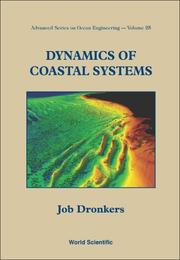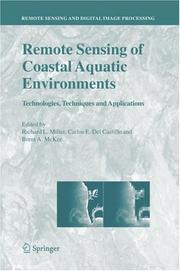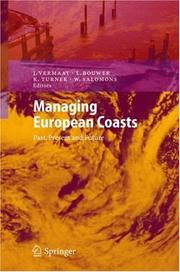| Listing 1 - 3 of 3 |
Sort by
|

ISBN: 1281928003 9786611928001 9812775250 9789812775252 9812563490 9812562079 9789812562074 Year: 2005 Publisher: Singapore Hackensack, N.J. World Scientific Pub. Co.
Abstract | Keywords | Export | Availability | Bookmark
 Loading...
Loading...Choose an application
- Reference Manager
- EndNote
- RefWorks (Direct export to RefWorks)
Dynamics of Coastal Systems is about the dynamic interaction between water motion and seabed topography, which affects the natural response of coastal systems to change in external conditions and to human interventions - from the scale of seabed ripples up to the scale of entire barrier and delta systems. The book highlights major concepts developed during the past 50 years for the description of current-topography, tide-topography and wave-topography interactions. It provides simple analytical tools and models for diagnosing and predicting coastal response to change, with references to a grea
Coast changes. --- Coasts. --- Coastal landforms --- Coastal zones --- Coastlines --- Landforms --- Seashore --- Coastal erosion --- Coasts --- Shore erosion --- Littoral drift --- Physical geography --- Erosion

ISBN: 1280283327 9786610283323 1402031009 Year: 2005 Publisher: Dordrecht : Springer,
Abstract | Keywords | Export | Availability | Bookmark
 Loading...
Loading...Choose an application
- Reference Manager
- EndNote
- RefWorks (Direct export to RefWorks)
Coastal waters are important ecological systems and vital assets for many nations. Coastal waters are also complex, dynamic environments where a vast array of coupled biological, chemical, geological, and physical processes occurs over multiple time and space scales. The optical environment of coastal waters is particularly complex. There is considerable interest in studying coastal waters to gain a better understanding of earth system processes for climatic change research or environmental factors for management decisions. Consequently, there is a need for robust, effective technologies and methods for studying these important complex environments. Remote sensing from aircraft and space-based platforms offers unique large-scale synoptic data to address the intricate nature of coastal waters. However, many researchers wishing to apply remote sensing to a dynamic coastal environment are faced with the challenge of learning a technology laden with new and often confusing terminology, data, and methods of processing and analysis. To gain an adequate understanding of remote sensing generally involves scouring countless technical manuals, reports, and scientific papers. Hence the major goal of writing this work was to produce a comprehensive resource for those involved in various studies of coastal aquatic environments. With its primary focus on optical remote sensing using passive instruments, the editors have indeed succeeded in creating a book the scientific community has been waiting for.
Oceanography --- Coasts --- Remote-sensing images. --- Remote sensing. --- Coastal landforms --- Coastal zones --- Coastlines --- Landforms --- Seashore --- Images, Remote-sensing --- Satellite images --- Side-looking airborne radar images --- SLAR (Side-looking airborne radar) --- Cartographic materials --- Ecology. --- Geographical information systems. --- Geography. --- Oceanography. --- Remote Sensing/Photogrammetry. --- Geoecology/Natural Processes. --- Geographical Information Systems/Cartography. --- Earth Sciences, general. --- Cosmography --- Earth sciences --- World history --- Geographical information systems --- GIS (Information systems) --- Information storage and retrieval systems --- Balance of nature --- Biology --- Bionomics --- Ecological processes --- Ecological science --- Ecological sciences --- Environment --- Environmental biology --- Oecology --- Environmental sciences --- Population biology --- Oceanography, Physical --- Oceanology --- Physical oceanography --- Thalassography --- Marine sciences --- Ocean --- Geography --- Ecology --- Geoecology. --- Environmental geology. --- Earth sciences. --- Geosciences --- Physical sciences --- Geoecology --- Environmental protection --- Physical geology --- Remote-sensing imagery --- Remote sensing systems --- Remote terrain sensing --- Sensing, Remote --- Terrain sensing, Remote --- Aerial photogrammetry --- Aerospace telemetry --- Detectors --- Space optics

ISBN: 1280306157 9786610306152 3540271503 3540234543 3642062482 Year: 2005 Publisher: Berlin ; New York : Springer,
Abstract | Keywords | Export | Availability | Bookmark
 Loading...
Loading...Choose an application
- Reference Manager
- EndNote
- RefWorks (Direct export to RefWorks)
Coastal zones play a key role in Earth System functioning and form an “edge for society” providing a significant contribution to the life support systems. Goods and services derived from coastal systems depend strongly on multiple transboundary interactions with the land, atmosphere, open ocean and sea bottom. Increasing demands on coastal resources driven by human habitation, food security, recreation and transportation accelerate the exploitation of the coastal landscape and water bodies. Many coastal areas and human activities are subject to increasing risks from natural and man-induced hazards such as flooding resulting from major changes in hydrology of river systems that has reached a global scale. Changes in the hydrological cycle coupled with changes in land and water management alter fluxes of materials transmitted from river catchments to the coastal zone, which have a major effect on coastal ecosystems. The increasing complexity of underlying processes and forcing functions that drive changes on coastal systems are witnessed at a multiplicity of temporal and spatial scales.
Coastal zone management --- Coastal ecology --- Coasts --- Coastal landforms --- Coastal zones --- Coastlines --- Landforms --- Seashore --- Coast ecology --- Coastal zone ecology --- Coastal biology --- Ecology --- Sublittoral ecology --- Coast ecosystem management --- Coastal ecosystem management --- Coastal management --- Coastal resource management --- Coastal resources management --- Coastal zone ecosystem management --- CRM (Coastal resource management) --- Zone management, Coastal --- Ecosystem management --- Natural resources --- Regional planning --- Coastal engineering --- Management --- Regional planning. --- Geochemistry. --- Oceanography. --- Landscape/Regional and Urban Planning. --- Biogeosciences. --- Oceanography, Physical --- Oceanology --- Physical oceanography --- Thalassography --- Earth sciences --- Marine sciences --- Ocean --- Chemical composition of the earth --- Chemical geology --- Geological chemistry --- Geology, Chemical --- Chemistry --- Regional development --- State planning --- Human settlements --- Land use --- Planning --- City planning --- Landscape protection --- Government policy --- Urban planning. --- Geobiology. --- Biology --- Biosphere --- Cities and towns --- Civic planning --- Land use, Urban --- Model cities --- Redevelopment, Urban --- Slum clearance --- Town planning --- Urban design --- Urban development --- Urban planning --- Art, Municipal --- Civic improvement --- Urban policy --- Urban renewal
| Listing 1 - 3 of 3 |
Sort by
|

 Search
Search Feedback
Feedback About UniCat
About UniCat  Help
Help News
News